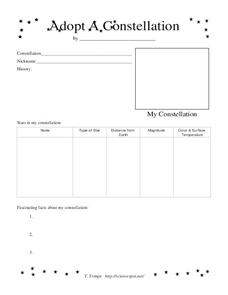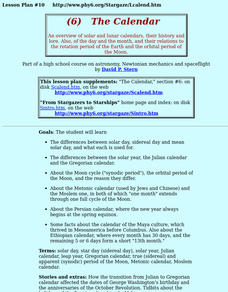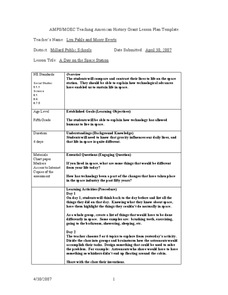Curated OER
Examining the Reasons for the Creation of the State of Israel
Students explore the connection between World War II and Jewish immigration to Israel after the War. In this World History lesson, students discuss the details of what it might have been like to live through the Holocaust. ...
Curated OER
Marine Environmental Geology
Students take this course as an introduction to the aspects of marine geology and oceanography that affect the environment and marine resources. Topics include estuarine oceanography and sediments, eutrophication of coastal waters,...
Curated OER
Adopt a Constellation
Learners adopt a constellation and find detailed information about their constellation. In this constellation lesson plan, students use the web to find information about a constellation of their choice. They identify the history of the...
Chicago Botanic Garden
Recent Weather Patterns
Decide whether weather is changing! A two-part activity first challenges classes to review the differences between weather and climate. Once finished, individuals then analyze historical data to determine if climate change is happening...
NASA
Measuring Dark Energy
You're only 10 minutes late? Do you know how much the universe has expanded in those 10 minutes? Scholars graph supernovae based on their redshift and see if the results verify Hubble's Law. If it does confirm it, the universe is...
Curated OER
Dinosaurs Were Real!
Students investigate the history of dinosaurs, as real animals. In this dinosaur lesson plan, students examine basic concepts that help them understand the history of all life. Included in this article is information on the world of the...
Curated OER
Predicting Lunar Eclipses
Students explore lunar eclipses and discover how to predict an eclipse the same way that ancient people did. They examine dates of recorded eclipses and find a pattern. Students apply an algorithm to the pattern.
Curated OER
Writing about the climate
Students research the contributing factors to the Earth's paleoclimate. They determine the relevant climate data and use it to construct a science argument. In the process, they access data, capture images of the data plots, and...
Curated OER
The Calendar
Students engage in an overview of solar and lunar calendars, their history and lore. Also, of the day and the month, and their relations to the rotation period of the Earth and the orbital period of the Moon.
Curated OER
Astrology: Fact Or Fiction?
Students investigate the concept of astrology and how it evolved from history. They use the Zodiac in order to find the location of constellations in the night sky. The differences between astrology and astronomy are compared and any...
Curated OER
Learning from Letters and Other Mail
Learners explore the history of our mail system. In this postal lesson plan, students evaluate mail as a means of communication, create a mail system in their classroom where they can send and receive mail. Once the learners receive...
Curated OER
Hubble Space Telescope
Young scholars investigate the history and use of the Hubble Space Telescope. They take a quiz in order to establish in any prior knowledge. Students conduct research to find information in conjunction with participating in class...
Curated OER
Overcoming Problems: John Smith
In this John Smith worksheet, students read a 1 1/2 page passage about the history of John Smith and answer short answer questions about it. Students complete 7 questions.
Curated OER
Blooming Thermometers
Students study phenology, or the study of climate change. They research the Japanese springtime festival of Hanami and plot and interpret average cherry blossom bloom date data from the past 1100 years.
Curated OER
Law in the Future
Learners develop a legal system. In this justice system lesson, students examine case law in the Untied States and draw on that experience to create a legal system for a "moon colony" which integrates the legal systems on Earth.
Curated OER
A River Ran Through It
Students research how water is used to generate electricity. They investigate water's potential-to-kinetic energy transfer in hands-on activities about falling water and waterwheels. They take measurements, calculate averages and graph...
Curated OER
Understanding Greek Mythology
Students explore the role of Greek mythology in ancient Greek life. They discuss the origins of the Greek gods and goddesses, conduct Internet research, and present a project in the form of a dialogue between a Greek god and a human...
Curated OER
How Do We Know?
High schoolers investigate the history of astronomy and how the study of constellations has evolved since the dawn of ancient civilization. They conduct research using a variety of resources. The teacher uses demonstrations to model how...
Curated OER
Calibrate Peer ReviewTM: Petroleum Geology of the Persian Gulf Region
Students explore the origin and distribution of oil and gas in a region of global significance, the Middle East including the geologic history and the socio-political and environmental issues associated with hydrocarbon exploration and...
Curated OER
Who Lives in the Arctic North?
Young scholars study the Arctic North. In this Canada history lesson, small groups of students research and then teach the class about either the plants, animals, humans, or geography in relation to the Arctic North. Young scholars make...
Curated OER
A Day on the Space Station
Fifth graders discover what it would be like to live in space. In this technological advancements lesson, 5th graders discuss how space life would be different from Earth life. Students also identify how technology has made life in space...
Curated OER
Surveying: 19 Chains and 50 Links
Through an interdisciplinary lesson, emerging engineers explore the history of surveying systems. After discussing various systems, they perform surveys on printable pages. Using their geometric skills, they physically stake out plots...
Curated OER
Typhoon Project
Students graph and outline the path of a typhoon. In this algebra lesson, students measure the path of the typhoon and create a graph with their data. They analyze the data and make predictions.
Curated OER
Law of Superposition
Students identify the law of superposition and it states that beds of rock in a series are laid down with the oldest at the bottom and younger layers on the top. They construct a legen for a block diagram and construct a block diagram...























